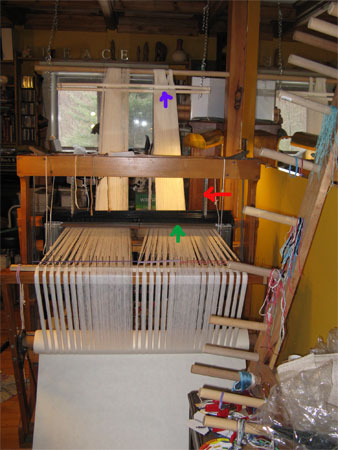Diane & Ellie wonder what changed in my processes to save me 5 hours in beaming sample wrap #2. I should have taken more photos, but didn’t, so I’ll have to do my best to explain it with words.
I did take one picture mid-beaming, so let’s start there.
I used a warping valet both times — that’s the rod you see hanging from my ceiling with chains. Laura Fry made me a warping valet convert some time ago. Was it 12 months? 18? I don’t know, but I do know it was a change I should have made years earlier.
The red arrow points to the chains that hang from my Mac. These chains hold up the harnesses, and as you can see are substantially narrower than the harnesses themselves. This was what caused me to make the biggest mistake on sample wrap #1.
Here’s my process to warp my loom.
- Hang the lease sticks from the castle behind the harnesses, using Texsolv so I can adjust the hanging height. Difference #1. (See below for explanations.)
- Put the warp chains on the lease sticks, and insert a dowel rod in the loop end. Tie that dowel to the back apron rod.
- Spread the warp in a raddle temporarily fixed to my back beam. Difference #2.
- Slide the lease sticks to the front of the harnesses, then under the front beam and up to the warping valet.
- Wind the thread on back beam, using packing paper, until the lease sticks are near the front beam. Then move to the front of the loom and move the lease sticks back up to the valet. Deal with sticky threads throughout. Difference #3.
- Repeat last step until all length is wound.
Difference #1:
- For the first sample my warp went over the top of the harnesses, down under the front beam, then up & over the valet. (This is the path I’ve always previously used for my warps.) I used my wooden lease sticks in the first sample. They are shorter and if I tilted them just a bit they would fit between those chains on the Mac. As you can see, if they (almost) fit between those chains, those lease sticks are definitely not as wide as the warp, which is the entire width of my harnesses. So I had to make the warp narrower in the lease sticks than they would be in the reed. Also, I admit it, I’ve not taken the time to use really fine sandpaper and make my wooden lease sticks completely smooth – there are little ‘catches’ on them in places.
- For the second sample wrap I used lease sticks I’d made from PVC pipe. These lease sticks are wider than the harnesses, so my warp could be spread as wide as it needed/wanted to be. In order to make the process work, I couldn’t narrow the warp to fit between those chains on the Mac. You can see in the photo (green arrow) that I moved all the heddles to the side and went through the center of the harnesses, not over the top. Also, the PVC is completely smooth – nothing to catch on ‘sticky’ threads, common to unmercerized cotton. You can see these PVC lease sticks in the photo by the purple arrow.
Difference #2:
- In sample 1, because I used those short lease sticks, I needed to spread the warp in the raddle to the same width as it was in the lease sticks. This obviously crammed the warp closer than it needed to be. And since I was setting the warp at 30 EPI in the reed (40 EPI at the selvedges), it was close indeed in the reed.
- For the second sample, with those longer lease sticks I could spread the warp to the width it would be in the reed. Plus, based on the feedback from my testing mamas, I was setting the threads farther apart to make the wrap thinner. I was using 26 EPI in the reed and 33 EPI at the selvedges.
Difference #3:
- Dealing with sticky threads. Unpleasant. Unmercerized cotton tends to be sticky. When it’s sett as closely together as mine was, this compounds the problem. Actually, my problem may well have started before I got to the loom at all. When I was at the warping mill I did not have my finger between the two threads, keeping them separate the whole time I was winding. But I’m sure that wasn’t the biggest problem. That was likely caused by me doing what I’ve always done, even though I know it is definitely not recommended by other weavers: I combed my warp in an attempt to ‘unstick’ threads. This is how I was taught, but I’ve subsequently read a preponderance of weavers who strongly recommend never combing the warp, instead ‘strumming’ any recalcitrant threads while under tension to get them back into the same order they were in at the mill.
- For the second warp I did keep my finger between the two threads at the warping mill. Also, I did not comb the warp. Combining these two changes with the ones noted above, the warp beamed super easily.
Let me know if you want more explanations.



Thanks for stopping back, Diane & Ellie. I have learned so much from other weavers, often when they didn’t even realize it, that I’m happy to share whatever information, tips, and tricks I can. If you’re like me, you’ll want and be able to incorporate some of it now, some maybe later.
Enjoy your weaving life!
Wow–thank you! Weavers are a generous bunch. We learn so much from one another. Thank you for the pics and detailed description, comparisons and words of wisdom plus time you took to share with us.
Very clear explanation – thanks! I do some of those things, but haven’t yet used a trapeze. You’re inspiring me to start nagging the husband to cut me a couple of 2×4’s and add holes at the end. (Don’t want to drill into the ceiling). Oh, and the pvc lease sticks are a great idea. Mine are as wide as my loom, but the roundness of the pvc may make the cross flow better, so I’ll try that, too!
I have had one warp, I used some old 8/2 unmercerized coton – it was the warp from hell, sticking to itself like mad. I haven’t had anything like that much trouble since, but I leave any questionable cotton for weft!